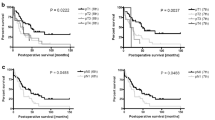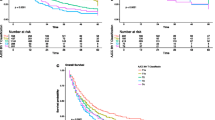Abstract
Aim
Two staging systems exist to classify extrahepatic cholangiocarcinoma (EHC), the TNM staging of the International Union Against Cancer (UICC) and the classification system of the Japanese Society of Biliary Surgery (JSBS). This study sought to evaluate the utility of these two staging systems.
Method
One hundred and twenty eight consecutive patients who underwent surgical resection were retrospectively classified into the appropriate stages using the UICC-TNM and JSBS systems. We also compared the distribution and survival curves of respective stages.
Results
Although the UICC-TNM staging system divided patients into seven categories, 106 of 128 patients (82.8%) fell into three stages (stages IA, IIA, or IIB). In contrast, patients were relatively evenly divided across the five categories in JSBS staging. The survival curve of UICC-TNM stage IIB was more similar to stage IV than stages IIA or III; survival rates for stages IIB and IV were significantly lower than the other stages. According to the JSBS staging system, there were significant differences between stages I and III, IVA and IVB, and II and IVA/IVB, and III and IVA/IVB.
Conclusions
Patients who underwent surgical resection were not evenly divided across UICC-TNM staging categories in comparison to JSBS staging. Stratification of survival ability was better when using the JSBS staging in comparison to the UICC-TNM system. The better understanding about distribution of patient classified by stage and stratification ability of survival of these two staging system may help surgeons assess the patients with EHC.



Similar content being viewed by others
References
Hayashi H, Ochiai T, Suzuki T, Shimada H, Hori S, Takeda A et al (2000) Superiority of a new UICC-TNM staging system for gastric carcinoma. Surgery 127:129–135
Kudo M, Chung H, Haji S, Osaki Y, Oka H, Seki T et al (2004) Validation of a new prognostic staging system for hepatocellular carcinoma: the JIS score compared with the CLIP score. Hepatology 40:1396–1405
Ueno S, Tanabe G, Sako K, Hiwaki T, Hokotate H, Fukukura Y et al (2001) Discrimination value of the new Western prognosis system (CLIP score) for hepatocellular carcinoma in 662 Japanese patients. Hepatology 34:529–534
International Union Against Cancer (UICC) (2002) TNM classification of malignant tumors, 6th edn. Wiley-Liss, New York
Japanese Society of Biliary Surgery (2003) General rules for surgical and pathological studies on cancer of the biliary tract, 5th edn. Kanehara, Tokyo
Kaplan EL, Meier P (1958) Nonparametric estimation from incomplete observations. J Am Stat Assoc 53:457–481
Hong SM, Kim MJ, Pi DY, Jo D, Cho HJ, Yu E et al (2005) Analysis of extrahepatic bile duct carcinomas according to the new American joint committee on cancer staging system focused on tumor classification problems in 222 patients. Cancer 104:802–810
Hong SM, Pawlik TM, Cho H, Aggarwal B, Goggins M, Hruban RH, Anders RA (2009) Depth of tumor invasion better predicts prognosis than the current American Joint Committee on Cancer T classification for distal bile duct carcinoma. Surgery 146:250–257
Hong SM, Presley AE, Stelow EB, Frierson HF Jr, Moskaluk CA (2006) Reconsideration of the histologic definitions used in the pathologic staging of extrahepatic bile duct carcinoma. Am J Surg Pathol 30:744–749
Jang JY, Kim SW, Park DJ, Ahn YJ, Yoon YS (2005) Choi MGet al. Actual long-term outcome of extrahepatic bile duct cancer after surgical resection. Ann Surg 241:77–84
Kayahara M, Nagakawa T, Ohta T, Kitagawa H, Tajima H, Miwa K (1999) Role of nodal involvement and the periductal soft-tissue margin in middle and distal bile duct cancer. Ann Surg 229:76–83
Cheng Q, Luo X, Zhang B, Jiang X, Yi B, Wu M (2007) Distal bile duct carcinoma: prognostic factors after curative surgery. A series of 112 cases. Ann Surg Oncol 14:1212–1219
Sasaki R, Takahashi M, Funato O, Nitta H, Murakami M, Kawamura H et al (2001) Prognostic significance of lymph node involvement in middle and distal bile duct cancer. Surgery 129:677–683
Acknowledgements
The author would like to express his deepest gratitude to the following physicians for their contributions to our research: Dr. Hiroyuki Matsuya, Dr. Hidetoshi Ohmori, and Dr. Hidehiro Toyoshima, my superiors in the First Department of Surgery, Iwate Medical University.
Author contributions
Sasaki R designed the research; Sasaki R, Takeda Y, Murata S, Oda T collected the data and drafted the manuscript; Wakabayashi Go assisted in interpretation of data and assisted in drafting the manuscript; Ohkohchi N participated in the design and final approval of the study and critical revision of the article.
Author information
Authors and Affiliations
Corresponding author
Rights and permissions
About this article
Cite this article
Sasaki, R., Murata, S., Oda, T. et al. Evaluation of UICC-TNM and JSBS staging systems for surgical patients with extrahepatic cholangiocarcinoma. Langenbecks Arch Surg 395, 615–623 (2010). https://doi.org/10.1007/s00423-010-0640-3
Received:
Accepted:
Published:
Issue Date:
DOI: https://doi.org/10.1007/s00423-010-0640-3




